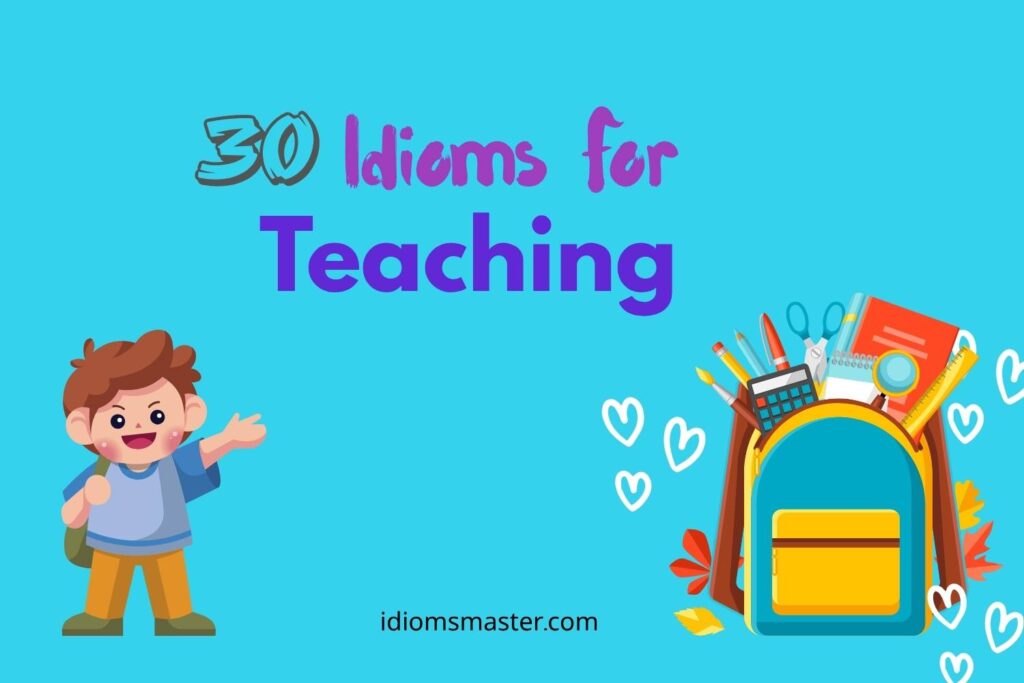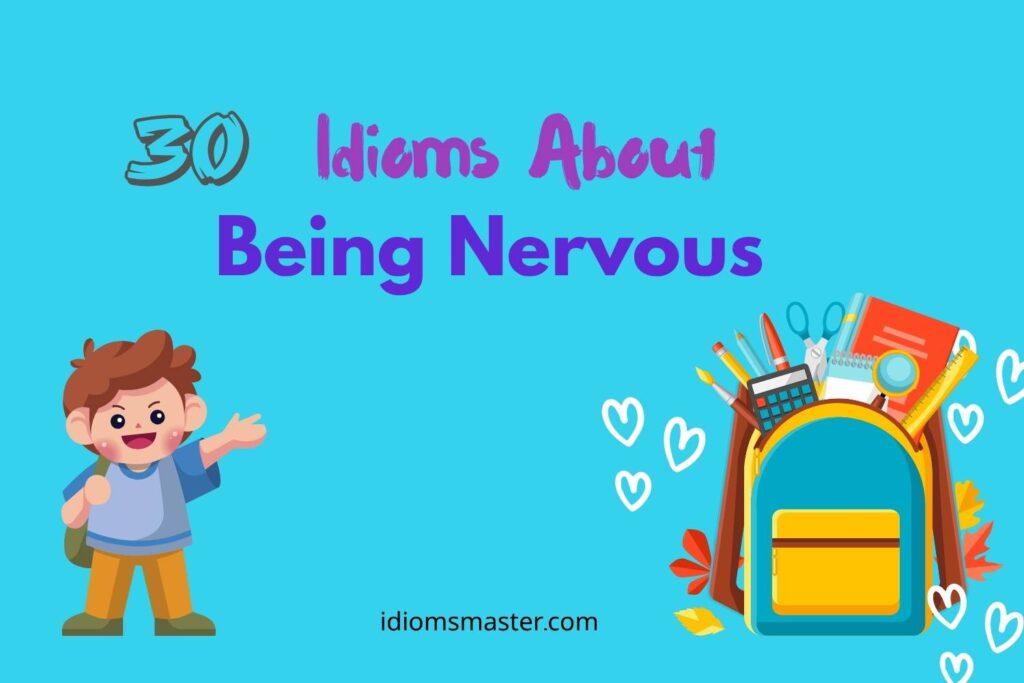Teaching isn’t just about giving answers; it’s about helping others understand and grow. When people talk about teaching, they often use idioms. Idioms are fun phrases that don’t mean exactly what the words say.
Instead of saying “She’s helping me learn,” someone might say “She’s showing me the ropes.” These expressions help us talk about teaching in a more colorful and interesting way. In this article, you’ll learn 30 idioms that people use when they talk about teaching, learning, and sharing knowledge.
Idioms for Teaching
1. Show the ropes
Meaning: Teach someone how to do something.
Samples: The teacher showed us the ropes of the new game. / He showed the new student the ropes.
To Put it Another Way: Teach how things work.
2. Teach the ropes
Meaning: Help someone learn the basics.
Samples: She taught me the ropes of the school play. / He teaches the ropes to all new kids.
To Put it Another Way: Teach the first steps.
3. Learn the ropes
Meaning: Learn how something is done.
Samples: I’m still learning the ropes of this math topic. / She learned the ropes quickly in class.
To Put it Another Way: Understand how things work.
4. Pass on knowledge
Meaning: Teach others what you know.
Samples: The teacher passed on her knowledge of writing. / Grandpa loves to pass on knowledge.
To Put it Another Way: Share what you’ve learned.
5. Plant a seed
Meaning: Start someone thinking or learning.
Samples: The teacher planted a seed in my mind about science. / That question planted a seed of curiosity.
To Put it Another Way: Begin a new idea or lesson.
6. Light a spark
Meaning: Get someone excited to learn.
Samples: Her story lit a spark for reading in me. / He lit a spark in the class with his experiment.
To Put it Another Way: Get someone interested.
7. Lead by example
Meaning: Teach by doing the right thing.
Samples: The teacher leads by example with her kindness. / He led by example during the group project.
To Put it Another Way: Show how to act by doing it.
8. Learn by doing
Meaning: Understand something through action.
Samples: We learn by doing in science class. / He learned by doing, not just reading.
To Put it Another Way: Learn through experience.
9. Learn the hard way
Meaning: Learn through a mistake.
Samples: I forgot my homework and learned the hard way. / She learned the hard way to ask questions.
To Put it Another Way: Learn by making a mistake.
10. A teachable moment
Meaning: A chance to teach during an everyday situation.
Samples: That accident was a teachable moment about safety. / The teacher used it as a teachable moment.
To Put it Another Way: A real-life time to learn.
11. Teach someone a lesson
Meaning: Help someone learn from a mistake.
Samples: That prank taught him a lesson. / The teacher used the story to teach a lesson.
To Put it Another Way: Learn through experience.
12. Open someone’s eyes
Meaning: Help someone understand something new.
Samples: The video opened our eyes to nature’s beauty. / That book opened my eyes to history.
To Put it Another Way: Help someone see something clearly.
13. Drill into someone
Meaning: Teach something through lots of practice.
Samples: The rules were drilled into us. / She drilled the spelling words every day.
To Put it Another Way: Repeat until it’s remembered.
14. Get the hang of it
Meaning: Begin to understand how to do something.
Samples: I finally got the hang of division. / He’s getting the hang of cursive.
To Put it Another Way: Starting to understand.
15. Break it down
Meaning: Explain something step by step.
Samples: Our teacher broke it down so we could all understand. / Let’s break it down together.
To Put it Another Way: Explain clearly and slowly.
16. Learn something by heart
Meaning: Memorize something fully.
Samples: I learned the poem by heart. / She knows the speech by heart.
To Put it Another Way: Remember every word.
17. Sink in
Meaning: Start to understand something.
Samples: The lesson took a while to sink in. / It finally sank in after we practiced.
To Put it Another Way: It started to make sense.
18. Go in one ear and out the other
Meaning: Not remembered or not listened to.
Samples: He told us twice, but it went in one ear and out the other. / Don’t let the directions go in one ear and out the other!
To Put it Another Way: Not paying attention.
19. Pick up on
Meaning: Learn or notice something new.
Samples: I picked up on a new math trick today. / She picked up on the rule quickly.
To Put it Another Way: Notice and understand.
20. Put it in simple terms
Meaning: Explain something in an easy way.
Samples: The teacher put it in simple terms. / Can you put that in simple terms for me?
To Put it Another Way: Say it so it’s easier to understand.
21. Hit the books
Meaning: Start studying.
Samples: We hit the books before the quiz. / He hit the books after school.
To Put it Another Way: Study hard.
22. Learn the basics
Meaning: Understand the simple beginning steps.
Samples: First, we learned the basics of painting. / She teaches the basics before moving on.
To Put it Another Way: Start with the easy parts.
23. Be a quick study
Meaning: Learn things fast.
Samples: He’s a quick study in science. / She’s a quick study and remembers everything.
To Put it Another Way: Learns fast.
24. Teach to the test
Meaning: Focus on teaching just for the test.
Samples: Some teachers only teach to the test. / We practiced essays instead of just teaching to the test.
To Put it Another Way: Only teaching test material.
25. In one ear and out the other
Meaning: Something is forgotten quickly.
Samples: The rule went in one ear and out the other. / Don’t let that go in one ear and out the other!
To Put it Another Way: Not remembered.
26. A sponge for knowledge
Meaning: Someone who loves learning and learns a lot.
Samples: She’s a sponge for knowledge in reading. / He’s like a sponge for knowledge.
To Put it Another Way: Loves to learn and remembers a lot.
27. Hammer it home
Meaning: Teach something clearly and strongly.
Samples: The teacher hammered it home with examples. / He hammered home the main idea.
To Put it Another Way: Teach something so it sticks.
28. Start from scratch
Meaning: Begin teaching from the beginning.
Samples: We had to start from scratch in the new unit. / She taught us from scratch how to do it.
To Put it Another Way: Begin at the very start.
29. Learning curve
Meaning: The time it takes to learn something.
Samples: There was a big learning curve with typing. / It had a steep learning curve, but we got it.
To Put it Another Way: Time it takes to figure something out.
30. Put into practice
Meaning: Use what you’ve learned.
Samples: We put our writing skills into practice. / She put the lesson into practice in her homework.
To Put it Another Way: Use the lesson in real life.
Find the Topics: Idioms for Teaching
Activity: “Mr. Lee’s Math Lesson”
Mr. Lee always made math fun. “Let’s put on our thinking caps,” he said with a grin. “Today we’re learning something new, but don’t worry, we’ll break it down together.” He drew a picture on the board to hammer it home.
Emily looked confused, so Mr. Lee asked, “Should I put it in simple terms?” She nodded, and soon it started to sink in. “It’s okay if you don’t get it right away,” he said. “We all have a learning curve.”
Later, he told the class, “Next week, you’ll put this into practice on your own.” Liam whispered to Maya, “Mr. Lee really knows how to light a spark when he teaches.”
Your Task:
Can you find and list all 8 idioms for teaching used in the story?
Answer Key
- Put on our thinking caps
- Break it down
- Hammer it home
- Put it in simple terms
- Sink in
- Learning curve
- Put into practice
- Light a spark
Conclusion
Teaching is more than giving facts; it’s about helping others understand and grow. Idioms like “break it down” or “put it into practice” help describe the many ways people teach and learn.
By using these idioms, you can talk about learning in more creative and clear ways. Whether you’re explaining something to a friend or trying to understand it yourself, teaching idioms makes the learning journey easier and more fun to share.




